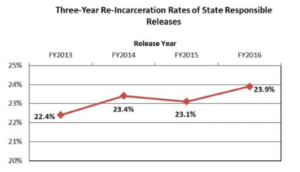 by Dick Hall-Sizemore
by Dick Hall-Sizemore
Recently, Governor Northam issued a press release applauding the Department of Corrections’ (DOC) most recent recidivism rate of 23.9% and noting it was one of the lowest in the country. All that is true and is highly commendable, but, as Paul Harvey used to say, “Now, for the rest of the story.”

Source: Virginia Dept. of Corrections
While a recidivism rate of 23.9% is excellent, it is actually an increase over the most previous rate of 23.1%. Although DOC likes to say that the most recent rate is “only” 0.8 of a percentage point more than the previous year, over the last four years, as shown by the accompanying graph, the recidivism rate rose from 22.4% to 23.9%, an increase of 1.5 percentage points.
Furthermore, although Virginia’s rate was among the lowest recidivism rates in the country (second lowest), for each of the four years prior to the last, the state had the lowest rate. In summary, although Virginia has an excellent recidivism rate, the rate has been increasing and Virginia has slipped a notch in relation to other states.
To be fair to DOC, there were some unusual circumstances that could explain much of the recent increase in recidivism. But, those explanations are not simple and do not fit neatly on a press release.
Before examining those explanations, it would be helpful to explain how recidivism is defined.
Recidivism is measured over a three-year interval from the date of an offender’s release. The most recent rate of 23.9% applies to those offenders released in 2016 and any criminal activity committed by them through 2019. DOC then waits a year to ensure that the court records are complete. The most recent recidivism data is for the 2016 cohort, for which DOC began analyzing the three-year data at the end of 2020.
Recidivism can be expressed in one of three ways:
- Re-arrest—any arrest reported for the three-year period in the Virginia State Police criminal history database for a felony or misdemeanor offense.
- Re-conviction—a conviction resulting from a re-arrest for a felony or misdemeanor during the three-year period.
- Re-incarceration—sentenced to a prison term for a felony within the three-year period, including for a felony committed prior to the release and for technical violations.
Unless specified otherwise, when DOC and Virginia officials refer to recidivism, they are referring to the re-incarceration rate. Because re-incarceration over a three-period is the measure most commonly used by states (42 states), it is the one used when comparing states. It also happens to be the lowest rate among the three.
Of the other two, re-arrest is the least useful. It likely reflects an attitude of “rounding up all the usual suspects.” The re-conviction rate is the best indicator of continued criminal activity by offenders after their release. Because the re-incarceration rate includes only offenders convicted and sent back to prison for a felony or technical violation, a released offender who was convicted of a misdemeanor, or even a felony, who either was sentenced only to jail time or had his new sentence suspended, would not show up in the re-incarceration rate. The re-conviction rate runs considerably higher than the re-incarceration rate.
To its credit, in its official reports, DOC shows all three recidivism rates. However, when generally discussing recidivism, politicians, DOC officials, and state staff stick to re-incarceration.
Next part: Some explanations for the increase
DOC source materials:
https://vadoc.virginia.gov/media/1680/vadoc-state-recidivism-report-2021-05.pdf
https://vadoc.virginia.gov/media/1683/vadoc-recidivism-summary-report-2021-04.pdf
https://vadoc.virginia.gov/media/1684/vadoc-state-recidivism-comparison-report-2021-04.pdf


